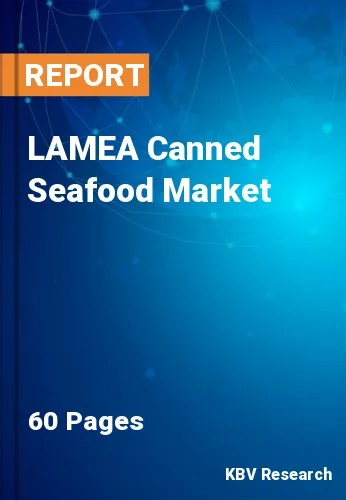The Latin America, Middle East and Africa Canned Seafood Market would witness market growth of 6.8% CAGR during the forecast period (2022-2028).
Canning is a method of preserving food that involves treating the contents of the food in a controlled atmosphere and sealing them in an airtight container. Moreover, canning enhances a product's shelf life, which is typically one to five years, though it can be considerably longer in some cases. Furthermore, consumers prefer meals that have been minimally processed and are free of synthetic preservatives, as well as hazardous fertilizer and antibiotic residues. As a result, canned seafood is the healthiest choice for customers, particularly athletes. Additionally, canned seafood is considered to have a longer shelf life and the capacity to keep and transfer it to other continents or countries when good quality seafood is rare due to resource constraints.
Canned seafood items are also known as thermally processed meat items due to their property of heat processing. The canned meat and seafood products are often categorized into two groups which are called sterilized preserved meat and pasteurized preserved meat. Both the categories of canned seafood products function in a distinct way with the ultimate aim to offer better quality preserved seafood.
The demand for canned seafood in this region is significantly increasing. According to the USDA Foreign Agricultural Service, South Africa's canned salmon imports have been steadily increasing for the past five years. The International Partnership for Human Development (IPHD) was seeking for a high-quality protein source in order to improve the diets of children in the International Food for Education and Child Nutrition Program in Guinea-McGovern-Dole Bissau. They resorted to Alaska Canned Salmon to meet their needs. While the Atlantic Ocean's coastal waters hold one of the world's largest fish reserves, local fish was out of range for the program's participants, who live on less than a dollar per day.
IPHD worked with the Alaska Global Food Aid Program, and the state of Alaska donated and shipped over 200,000 cans of salmon. Salmon, which is high in protein, improved the nutritional quality of 38,000 primary school as well as kindergarten children's meals. Canned salmon was successfully included into food aid programs in Guinea-Bissau.
The Brazil market dominated the LAMEA Canned Seafood Market by Country in 2021, and would continue to be a dominant market till 2028; thereby, achieving a market value of $1,007.5 Million by 2028. The Argentina market is estimated to grow at a CAGR of 7.3% during (2022 - 2028). Additionally, The UAE market would witness a CAGR of 6.5% during (2022 - 2028).
Based on Distribution Channel, the market is segmented into Retail and Foodservices. Based on Product, the market is segmented into Tuna, Salmon, Prawns, Shrimps, Sardines, and Others. Based on countries, the market is segmented into Brazil, Argentina, UAE, Saudi Arabia, South Africa, Nigeria, and Rest of LAMEA.
Free Valuable Insights: The Global Canned Seafood Market is Predict to reach $42.1 Billion by 2028, at a CAGR of 5.3%
The market research report covers the analysis of key stake holders of the market. Key companies profiled in the report include F.C.F. Fishery Co., Ltd., StarKist (Dongwon Industries), Nippon Suisan Kaisha, Ltd., Universal Canning, Inc., LDH (La Doria) Ltd., Thai Union Group PLC, American Tuna, Inc., Maruha Nichiro Corporation, Wild Planet Foods, Inc., and Trident Seafoods Corporation.
By Distribution Channel
By Product
By Country
Our team of dedicated experts can provide you with attractive expansion opportunities for your business.

